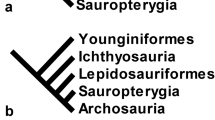Abstract
Vagile animals usually have bilaterally symmetrical bodies and proceed with their mouth-end first. Regular sea urchins have, however, radially symmetrical bodies with their mouth facing the substratum and show no preference in which side of the body should be anterior in their locomotion. The elliptical sea urchins in the subfamily Echinometrinae are exceptional among regular sea urchins in having elongated bilateral bodies. We studied whether they showed the preference in the direction of locomotion using Echinometra sp. type A. Directional preference was not observed in the proceedings in an open space. However, they proceeded preferentially with their long axis coinciding with the direction of locomotion when they moved along the water surface or along the wall of the aquarium. The speed of locomotion was the same irrespective of the direction of proceedings and of whether sea urchins moved freely or moved along the water surface or along the walls. We suggest that the bilateral body form and the habit of long-axis lead of this sea urchin have adaptive significance to increase the protected body surfaces, not to facilitate the efficiency in locomotion.




Similar content being viewed by others
References
Batschelet E (1981) Circular statistics in biology. Academic Press, New York
Beklemishev VN (1969) Principles of comparative anatomy of invertebrates. The University of Chicago Press, Chicago
Carpenter RC (1984) Predator and population density control of homing behavior in the Caribbean echinoid Diadema antillarum. Mar Biol 82:101–108
Cole LJ (1913) Direction and locomotion of the starfish (Asterias forbesi). J Exp Zool 14:1–31
Crook AC, Long M, Barnes DKA (2000) Quantifying daily migration in the sea urchin Paracentrotus lividis. J Mar Biol Assoc UK 80:177–178
Dance C (1987) Patterns of activity of the sea urchin Paracentrotus lividis in the bay of Port-Cros. Mar Ecol 8:131–142
Denny M, Gaylord B (1996) Why the urchin lost its spines: hydrodynamic forces and survivorship in three echinoids. J Exp Biol 199:717–729
Domenici P, Gonzales-Calderon D, Ferrari RS (2003) Locomotor performance in the sea urchin Paracentrotus lividis. J Mar Biol Assoc UK 83:285–292
Fricke HW (1971) Fische als Feinde tropischer Seeigel. Mar Biol 9:328–338
Grabowsky GL (1994) Symmetry, locomotion, and the evolution of an anterior end: a lesson from sea urchins. Evolution 48:1130–1146
Hyman LH (1955) The Invertebrates: Echinodermata, 4. Echinoidea. McGraw-Hill, New York
Ito Y, Hayashi I (1998) Basic behavior of three species of sea urchins under experimental conditions. In: Mooi R, Telford M (eds) Echinoderms. A. A. Balkema, Rotterdam, p 694
James DW (2000) Diet, movement, and covering behavior of the sea urchin Toxopneustes roseus in rhodolith beds in the Gulf of California, Mexico. Mar Biol 137:913–923
Kier PM (1987) Class Echinoidea. In: Boardman RS, Cheetham HC, Rowell AJ (eds) Fossil Invertebrates. Blackwell, Oxford, pp 596–611
Linares C, Coma R, Dias D, Zabala M, Hereu B, Dantart L (2005) Immediate and delayed effects of a mass mortality event on gorgonian population dynamics and benthic community structure in the NW Mediterranean Sea. Mar Ecol Prog Ser 305:127–137
McClanahan TR (1995) Fish predators and scavengers of the sea urchin Echinometra mathaei in Kenyan coral-reef marine parks. Environ Biol Fishes 43:187–193
McClanahan TR, Muthiga NA (1989) Patterns of predation on a sea urchin, Echinometra mathaei (de Blainville), on Kenyan coral reefs. J Exp Mar Biol Ecol 126:77–94
Millott N, Yoshida M (1957) The spectral sensitivity of the Echinoid Diadema antillarum Philippi. J Exp Biol 34:394–401
Nelson BV, Vance RR (1979) Diel foraging patterns of the sea urchin Centrostephanus coronatus as a predator avoidance strategy. Mar Biol 51:251–258
Nishihira M, Sato Y, Arakaki Y, Tsuchiya M (1991) Ecological distribution and habitat preference of four types of the sea urchin Echinometra mathaei on the Okinawan coral reefs. In: Yanagisawa T, Yasumasu I, Oguro C, Suzuki N, Motokawa T (eds) Biology of Echinodermata. A. A Balkema, Rotterdam, pp 91–104
Parker GH (1936) Direction and means of locomotion in the regular sea urchin Lytechinus. Mém du Mus Roy d’Hist Nat de Bel, deu sér Fasc 3:197–208
Rahman MA, Uehara T (2004) Interspecific hybridization and backcrosses between two sibling species of pacific sea urchins (genus Echinometra) on Okinawan intertidal reefs. Zool Stud 43:93–111
Smith AB (1988) Phylogenetic relationship, divergence times, and rates of molecular evolution for Camarodont sea urchins. Mol Biol Evol 5:345–365
Tuya F, Martin JA, Luque A (2004) Patterns of nocturnal movement of the long-spined sea urchin Diadema antillarum (Philippi) in Gran Canaria (the Canary Islands, central East Atlantic Ocean). Helgol Mar Res 58:26–31
Uehara T (1990) Speciation in Echinometra mathaei. Iden 44:47–53 (In Japanese)
Wainwright SA (1988) Axis and circumference. Harvard University Press, Cambridge
Zar JH (1999) Biostatistical analysis. Peason Education, Singapore
Acknowledgments
We would like to thanks the anonymous reviewer, Dr. H-A. Takeuchi of Shizuoka University and Dr. M. Hironaka of Hamamatsu University School of Medicine for the information on circular statistics. We would like to express thanks Dr. O. Ellers of Bowdoin College for improvement of statistical method description. We are grateful to Y. Nakano of Sesoko Marine Science Center and M. Obuchi of Tokyo Institute of Technology for collecting sea urchins. This work was supported by the Grant-in-Aid for Scientific Research (C) (No. 18916007) from the Ministry of Education, Culture, Sports, Science and Technology, Japan, and the grant of Research Institute of Marine Invertebrates, Japan to K.Y.
Author information
Authors and Affiliations
Corresponding author
Additional information
Communicated by S. Nishida.
Rights and permissions
About this article
Cite this article
Yoshimura, K., Motokawa, T. Bilateral symmetry and locomotion: do elliptical regular sea urchins proceed along their longer body axis?. Mar Biol 154, 911–918 (2008). https://doi.org/10.1007/s00227-008-0984-1
Received:
Accepted:
Published:
Issue Date:
DOI: https://doi.org/10.1007/s00227-008-0984-1




